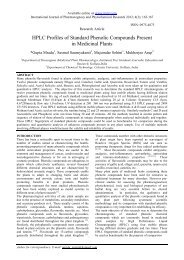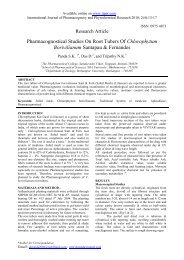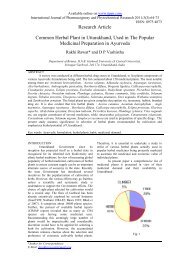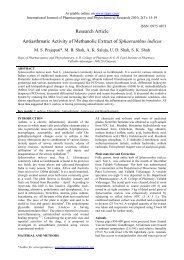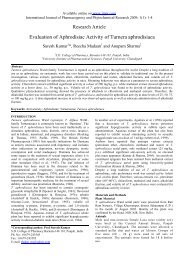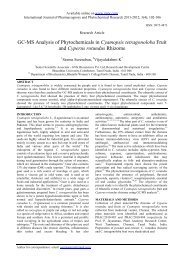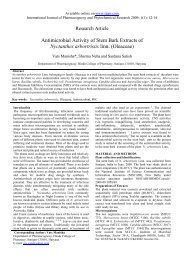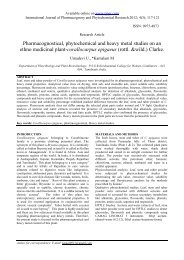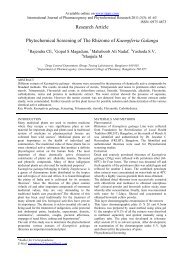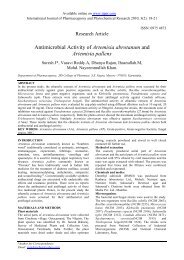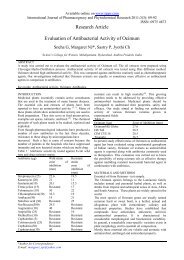Full Text PDF - International Journal of Pharmacognosy and ...
Full Text PDF - International Journal of Pharmacognosy and ...
Full Text PDF - International Journal of Pharmacognosy and ...
You also want an ePaper? Increase the reach of your titles
YUMPU automatically turns print PDFs into web optimized ePapers that Google loves.
Available online on www.ijppr.com<br />
<strong>International</strong> <strong>Journal</strong> <strong>of</strong> <strong>Pharmacognosy</strong> <strong>and</strong> Phytochemical Research 2012-13; 4(4); 213-218<br />
Research Article<br />
ISSN: 0975-4873<br />
Evaluation <strong>of</strong> Anti-Obesity Activity <strong>of</strong> Lantana camara Var Linn. by<br />
Progesterone Induced Obesity on Albino Mice<br />
* 1 Rohit Gundamaraju, 1 Sartaj Banu Mulaplli, 2 Dr.Ramesh.C.<br />
Department <strong>of</strong> Pharmacolgy , Malla Reddy Institute <strong>of</strong> Pharmaceutical Sciences , Maisammagud , Dhulapally(Post via<br />
Hakimpet) ,Secunderabad (500014), AP,India.<br />
2<br />
GSN Pharmaceuticals Pvt .Ltd., Rajeev G<strong>and</strong>hi Nagar, Kukatpally, Hyderabad (500072),AP,India.<br />
ABSTRACT<br />
The anti-obesic activity <strong>of</strong> Lantana camara was studied on progesterone induced models <strong>of</strong> hyperlipedemia in mice.<br />
Hyperlipidemia condition established by progesterone, which changed various parameters in the body . An increase in<br />
food consumption <strong>and</strong> water consumption usually accompanies the body weight gain, which is the characteristic nature<br />
<strong>of</strong> progesterone stimulation. Increased consumption <strong>of</strong> food <strong>and</strong> water generally leads to elevated parameters like<br />
LDL,VLDL, serum cholesterol etc. Accumulation <strong>of</strong> fat in areas like inguinal, epididymal , neck etc. was observed .<br />
Ethanobotanical knowledge <strong>of</strong> medicinal plants is one <strong>of</strong> the most prominent source <strong>of</strong> new drugs <strong>and</strong> has shown<br />
potential results for treatment <strong>of</strong> obesity. Preliminary phytochemical analysis <strong>of</strong> Lantana camara revealed the presence<br />
<strong>of</strong> phyto constituents such as steroids , flavinoids , alkaloids, etc.<br />
Keywords: Adipocyte, progesterone, Obesity<br />
INTRODUCTION<br />
Obesity is a chronic metabolic disorder caused by an<br />
imbalance between energy intake <strong>and</strong> expenditure. Over<br />
weight <strong>and</strong> obesity are defined as abnormal or excessive<br />
fat accumulation that presents a risk to health. Obesity is<br />
one <strong>of</strong> the greatest health threats <strong>of</strong> this century. Chronic<br />
obesity is a problem <strong>of</strong> epidemic proportions, <strong>and</strong> is<br />
rapidly increasing in prevalence in both the West <strong>and</strong> the<br />
Asia-Pacific region¹ ˉ² which has an important impact<br />
on life style-related diseases such as coronary heart<br />
disease, dyslipidemia, glucose intolerance, diabetics,<br />
hypertension <strong>and</strong> some cancers³ . Several factors,<br />
including lack <strong>of</strong> exercise, sedentary lifestyles <strong>and</strong> the<br />
consumption <strong>of</strong> energy rich diets are contributory to the<br />
etiology <strong>of</strong> obesity⁴. Despite the urgent need for safe <strong>and</strong><br />
efficient therapeutics <strong>and</strong> the potential size <strong>of</strong> the market<br />
for anti-obesity drugs, the current status for the<br />
development <strong>of</strong> such drugs are still unsatisfactory ⁵.<br />
Some edible medicinal plants have been used as dietary<br />
supplements for body-weight management <strong>and</strong> control in<br />
many countries⁶ˉ⁷ .<br />
In the literature survey, it was found that flavonoids,<br />
sterols, tannins, <strong>and</strong> alkaloids have shown promising<br />
effects to tackle obesity by various mechanisms, Lantana<br />
camara whole plant has shown the presence <strong>of</strong> sterols,<br />
triterpenoids, flavonoids alkaloids <strong>and</strong> saponins, <strong>and</strong><br />
others in the extracts. Moreover, traditional Indian<br />
medicine also claims for its antiobesity activity. With this<br />
back ground, this plant has been selected for its<br />
phytochemical analysis <strong>and</strong> screening <strong>of</strong> its antiobesity<br />
activity against progesterone-induced obesity in female<br />
mice. The neuroactive steroid, progesterone is a female<br />
reproductive hormone. Its level increases during the later<br />
phase <strong>of</strong> the menstrual cycle <strong>and</strong> controls the secretory<br />
phase <strong>of</strong> the endometrium. Substantial evidence links<br />
progesterone excess in pathophysiology <strong>of</strong> eating <strong>and</strong><br />
affective disorders. Some reports suggest the use <strong>of</strong><br />
progesterone-containing preparations as contraceptive or<br />
for the hormone replacement therapy to cause sufficient<br />
weight gain by causing hyperphagia <strong>and</strong> increased fat<br />
deposition in the body⁸. Reports also suggest that<br />
progesterone can produce these effects by inducing<br />
myriad <strong>of</strong> neurotransmitter changes <strong>of</strong> which alterations<br />
<strong>of</strong> serotonin level can have important. With this setting<br />
neuroactive to induce obesity in female mice has been<br />
chosen.<br />
MATERIALS AND METHODS<br />
Collection <strong>of</strong> plant material: Lantana camara whole plants<br />
materials were collected from Tirupathi . The plant<br />
authentication was done by Department <strong>of</strong> Botany,Sri<br />
Venkateshwara University , Tirupathi dist. Chittoor ,<br />
Andhra Pradesh, <strong>and</strong> the voucher was preserved.<br />
Preparation <strong>of</strong> the extract: Leaves <strong>of</strong> Lantana camara<br />
were shade dried at room temperature for 2-3 days. These<br />
dried leaves were then powdered in a mixture. The<br />
extraction process was done in a Soxhlet extractor. The<br />
fine powder (100 grams ) was suspended in (200 ml) <strong>of</strong><br />
methanol for 24 hours at room temperature. After<br />
extraction , the solvent was evaporated by rotary<br />
evaporator <strong>and</strong> the residue was dried.⁹<br />
Experimental animals: Female albino mice (20–25 g)<br />
were used in this study. Mice bred at GSN<br />
Pharmaceuticals PVT.LTD animal house were used in<br />
this experiment. Animals were housed in a st<strong>and</strong>ard<br />
controlled animal care facility in cages (5 mice/cage).<br />
Author for correspondence: E-mail: rohit.gundamaraju@gmail.com
Rohit Gundamaraju et,al./ Evaluation <strong>of</strong> Anti-Obesity…<br />
The following table consists <strong>of</strong> the data derived from the results <strong>of</strong> the histopathology <strong>of</strong> the various slides consisting<br />
<strong>of</strong> the organs(liver) sections <strong>of</strong> various groups. The table consists <strong>of</strong> the inducing agent, size <strong>of</strong> the organs, changes<br />
observed, <strong>and</strong> conclusions drawn.<br />
S.N GROUP SIZE COLOR INFERENCE CONCLUSION<br />
O<br />
1. INDUCING<br />
AGENT<br />
Slight<br />
increase<br />
normal Mild fatty change The liver is prone to fatty diet,as<br />
there is increase in the fat cells.<br />
2. INDUCING<br />
AGENT +<br />
TREATED<br />
DRUG<br />
EXTRACT<br />
3. INDUCING<br />
AGENT +<br />
TREATED<br />
DRUG<br />
EXTRACT(D<br />
OUBLE<br />
DOSE)<br />
4. INDUCING<br />
AGENT +<br />
STANDARD<br />
normal normal Positive necrosis,focal<br />
necrosis<br />
<strong>of</strong><br />
hepatocytes,swelling found<br />
normal normal Focal necrosis,swelling <strong>of</strong><br />
hepatocytes with change in<br />
the cells <strong>and</strong> degenation in<br />
some places,<br />
normal normal Mild necrosis found. Less<br />
extent when compared to 2 nd<br />
<strong>and</strong> 3 rd conditions.<br />
DRUG<br />
The animals were maintained in a temperature-controlled<br />
room (22°C–25°C, 45% humidity) on a 12:12 h dark:light<br />
cycle. The animals were maintained under st<strong>and</strong>ard<br />
nutritional <strong>and</strong> environmental conditions throughout the<br />
experiment. All the experiments were carried out between<br />
9:00–16:00 hours at ambient temperature. Nations<br />
CPCSEA guidelines were strictly followed <strong>and</strong> all the<br />
studies were approved by the Institutional Animal Ethics<br />
Committee (IAEC).<br />
Preliminary Phytochemical analysis: The methanol<br />
extract <strong>of</strong> Lantana camara was subjected to preliminary<br />
phytochemical analysis to assess the presence <strong>of</strong> various<br />
phytoconstituents; it revealed the presence <strong>of</strong> flavonoids,<br />
alkaloids <strong>and</strong> glycosides. All these tests were performed<br />
at GSN Pharmaceuticals PVT.LTD.<br />
Induction <strong>of</strong> progesterone-induced obesity: Progesterone<br />
vial contents were dissolved in arachis oil <strong>and</strong> a dose <strong>of</strong><br />
10 mg/kg was administered subcutaneously in the dorsal<br />
neck region to mice for 28 days, control group received<br />
the vehicle. All drugs were given at a dose <strong>of</strong> 0.4 mL/100<br />
g body weight. The test drugs were injected 30 min<br />
before progesterone administration.¹⁰<br />
Test drug preparation: the extract <strong>and</strong> st<strong>and</strong>ard<br />
sibutramine are soluble in water, so distilled water was<br />
used as media to dissolve. For progesterone, arachis oil<br />
was used as a vehicle <strong>and</strong> diluent for appropriate doses.<br />
All the drug concentrations were prepared freshly just<br />
before administration. All the test drugs, including the<br />
st<strong>and</strong>ard were given by oral gavages by p.o. route.<br />
EVALUATION<br />
Body weight: The body weights <strong>of</strong> mice (g) were<br />
recorded every week for 28 days in each group just before<br />
dosing by using precision balance <strong>of</strong> 10 mg sensitivity.<br />
Extract found to show effect on<br />
liver.fatty change is abscent ,drug<br />
extract found to show its action on<br />
the fatty liver.<br />
Extract found to show its action on<br />
liver,fatty change is abscent,drug<br />
extract found to show its action on<br />
the fatty liver<br />
Action <strong>of</strong> the drug is mild when<br />
compared to 2 nd <strong>and</strong> 3 rd<br />
conditions,drug having mild<br />
properties<br />
Biochemical parameters: Preparation <strong>of</strong> serum: On day<br />
29 <strong>of</strong> the study, that is, after the last test drug<br />
administration, the mice were anesthetized under light<br />
ether anesthesia <strong>and</strong> blood for serum preparation was<br />
collected by retro orbital puncture, using 10 μL×20 mm<br />
(L) × 0.8 mm (2R) glass capillary into sterile EDTAcoated<br />
tube (3 mg/mL) for the estimation. Blood was kept<br />
in wet ice for 30 min, centrifuged for 5 min at 4000 rpm<br />
at 4°C (REMIMAK, Remi Instruments Ltd, Mumbai,<br />
India) <strong>and</strong> plasma was aspirated out for the analysis <strong>of</strong><br />
lipid pr<strong>of</strong>ile. The serum was stored in the refrigerator for<br />
the analysis <strong>of</strong> biochemical parameters. All analyses on<br />
serum were completed within 24 h <strong>of</strong> sample collection.<br />
Serum samples were analysed at AZ<br />
Laboratory(Hyderabad).<br />
STATISTICAL ANALYSIS<br />
The results are expressed as mean±SEM. Comparisons<br />
between the treatment groups <strong>and</strong> positive control;<br />
positive control <strong>and</strong> control were performed by one-way<br />
analysis <strong>of</strong> variance (ANOVA) followed by Dunnett's<br />
test. In all the tests the criterion for statistical significance<br />
was P
Rohit Gundamaraju et,al./ Evaluation <strong>of</strong> Anti-Obesity…<br />
Triglycerides; HDL-C – High density lipoprotein<br />
cholesterol; LDL-C – Low density lipoprotein<br />
cholesterol; VLDL – Very low density lipoprotein<br />
cholesterol; SGOT – Serum glutamate oxaloacetate<br />
transaminase; SGPT – Serum glutamate pyruvate<br />
transaminase; Progesterone induced group have shown<br />
significant increase in TG, LDL-C, VLD-C, SGOT <strong>and</strong><br />
SGPT level <strong>and</strong> reduction in HDL-C level compared<br />
to normal control mice. Treatment with MECP 200 <strong>and</strong><br />
400 mg/kg have shown significant increase in HDL-C<br />
<strong>and</strong> reduction in other biochemical parameters.<br />
Sibutramine have shown most significant results by<br />
increasing in HDL-C level <strong>and</strong> reduction in TG, LDL-C,<br />
VLDL-C, SGOT <strong>and</strong> SGPT level compared with<br />
progesterone induced <strong>and</strong> any Lantana camara treated<br />
group. *Comparison <strong>of</strong> test <strong>and</strong> disease control with<br />
normal control; #Comparison test with disease control<br />
DISCUSSION<br />
Obesity is a medical condition in which excess body fat<br />
has accumulated to the extent that it may have an adverse<br />
effect on health, leading to reduced life expectancy <strong>and</strong>/or<br />
increased health problems¹¹. Body mass index (BMI), a<br />
measurement which compares weight <strong>and</strong> height, defines<br />
people as over weight (pre-obese) if their BMI is between<br />
25 <strong>and</strong> 30 kg/m2, <strong>and</strong> obese when it is greater than<br />
30 kg/m2.<br />
Obesity increases the likelihood <strong>of</strong> various diseases ,<br />
The following are the microscopic images <strong>of</strong> the histopathology <strong>of</strong> various groups <strong>of</strong> liver samples:<br />
Progesterone induced: The presence <strong>of</strong> the fatty change in the liver cells shows that the progesterone has successfully<br />
responsible for the induction <strong>of</strong> obesity <strong>and</strong> the occurance <strong>of</strong> fat globules<br />
Fatty change in hepatocytes<br />
MELc 200mg/kg+pro: The methanolic extract <strong>of</strong> 200mg <strong>of</strong><br />
Lantana camara brought changes like focal necrosis, <strong>and</strong><br />
slight hepato toxicity, which proves that there is action opf<br />
the drug <strong>and</strong> absence <strong>of</strong> fat globules.<br />
Fatty change in hepatocytes<br />
Swelling <strong>of</strong> hepatocytes focal Necrosis +<br />
Swelling with focal necrosis<br />
MELc 400mg+pro: In this extract, there is significant <strong>and</strong><br />
increased focal necrosis <strong>and</strong> total absence <strong>of</strong> fat globules<br />
<strong>and</strong> this extract shows perfect decrease in the fat cells<br />
which were induced by progesterone.<br />
Focal necrosis<br />
Page215<br />
IJPPR, Vol-4, Issue 4, December 2012- February 2013, 213-218
Rohit Gundamaraju et,al./ Evaluation <strong>of</strong> Anti-Obesity…<br />
Swelling <strong>of</strong> hepatocytes<br />
Sibutramine 10mg/kg+pro: In this case there was mild<br />
necrosis found.<br />
Swelling <strong>of</strong> hepatocytes<br />
Mild necrosis–central vein<br />
Few damaged cells<br />
Treatment<br />
Glucose<br />
(mg/dl)<br />
TC<br />
(mg/dl)<br />
TG<br />
(mg/dl<br />
HDL-C<br />
(mg/dl)<br />
LDL-C<br />
(mg/dl)<br />
VLDL-C<br />
(mg/dl)<br />
SGOT<br />
(IU/L)<br />
SGPT (IU/L)<br />
Control<br />
(Vegetable<br />
oil)<br />
Progesteron<br />
e<br />
MELc (200<br />
mg/kg)<br />
+ Pro<br />
MELc (400<br />
mg/kg)<br />
+ Pro<br />
Sibutramine<br />
10mg/kg+pro<br />
135.67±1<br />
4.01<br />
188.43±1<br />
0.19<br />
144.35±<br />
9.65<br />
118.3±5.<br />
69<br />
136.33±<br />
6.66*<br />
100.16±1<br />
6.65<br />
137.17±<br />
11.37<br />
143.11±1<br />
4.62<br />
126.01±7<br />
.67<br />
66.4±4.<br />
74**<br />
79.905±<br />
7.29<br />
147.15±1<br />
3.23<br />
113.43±<br />
9.28<br />
94.8±6.1<br />
1*<br />
57.37±5.<br />
95**<br />
26.06±0.5<br />
55<br />
19.28±0.7<br />
13**<br />
21.31±1.02<br />
4**<br />
26.89±1.0<br />
45 ##<br />
57.29±1<br />
6.61<br />
84.45±1<br />
3.01<br />
103.18±1<br />
4.63<br />
80.165±<br />
8.00<br />
30.97±0.8 30.97±0<br />
41** ## .841 #<br />
15.81±1.4<br />
57<br />
29.43±2.6<br />
46**<br />
22.686±1.<br />
85<br />
18.96±1.2<br />
2<br />
11.47±1.1<br />
8 ##<br />
137.23±<br />
6.51<br />
153.68±<br />
11.77<br />
144.2±1<br />
4.04<br />
109.1±21.<br />
06<br />
114.7±12<br />
.16<br />
68.88±6.99<br />
97.25±9.31<br />
141.58±14.54<br />
107.03±18.35<br />
Values are expressed as mean ± SEM. Levels <strong>of</strong> significance- Group II compared with Group I,III <strong>and</strong> IV. **p_0.01 <strong>and</strong><br />
***p_0.001.<br />
8<br />
0.<br />
9<br />
7<br />
±<br />
7.<br />
5<br />
6<br />
particularly heart disease , type2 diabetis, obstructive<br />
sleep apnea, certain types <strong>of</strong> cancer, <strong>and</strong> osteoarthritis.<br />
Obesity is most commonly caused by a combination <strong>of</strong><br />
excessive food energy intake, lack <strong>of</strong> physical activity,<br />
<strong>and</strong> genetic susceptibility, although a few cases are<br />
caused primarily by genes, endocrine disorders,<br />
medications or psychiatric illness. Evidence to support<br />
the view that some obese people eat little yet gain weight<br />
due to a slow metabolism is limited; on average obese<br />
people have a greater energy expenditure than their thin<br />
counterparts due to the energy required to maintain an<br />
increased body mass.¹²<br />
In medical sciences many attempts have been made to<br />
correct this disorder, producing a number <strong>of</strong> agents<br />
including fibrates , sibutramine, <strong>and</strong> drugs like orlistat but<br />
unfortunately they are teamed with lots <strong>of</strong> adverse<br />
effects¹³ˉ¹⁴. Due to various reasons like cost factor,<br />
adverse effects etc.. the essentiality <strong>of</strong> devolopment <strong>of</strong><br />
herbal formulations are been enhanced. Due to this effort,<br />
herbal formulations may be regarded as an excellent<br />
Page216<br />
IJPPR, Vol-4, Issue 4, December 2012- February 2013, 213-218
Rohit Gundamaraju et,al./ Evaluation <strong>of</strong> Anti-Obesity…<br />
alternative strategy for devoloping future effective , <strong>and</strong><br />
safe anti-obesity drugs. A variety <strong>of</strong> natural products<br />
including crude extracts <strong>and</strong> isolated compounds from<br />
plants , can add up the effort to body weight reduction<br />
<strong>and</strong> prevent diet induced obesity . Therefore they have<br />
been widely used in treating obesity.¹⁵ˉ¹⁶<br />
Several plant extracts in traditional medicine are been<br />
used to treat obesity with deleted adverse effects. Plants<br />
like Camellia sinensis(L), Citrus aurantium L. , Salix<br />
matsudana Koidzumi, Nelumbo nucifera, Hibiscus<br />
sabdariffa L. are been used traditionally.¹⁷ˉ¹⁸<br />
Lantana camara Linn.(Verbenaceae) is a plant which is<br />
commonly known as wild sage- notorious weed. It is an<br />
annual plant which grows upto 1.2-2.4 m high <strong>and</strong> has<br />
various uses in folklore medicine in many parts <strong>of</strong> the<br />
world¹⁹ˉ²⁰. The leaves are reported to be useful in the<br />
treatment <strong>of</strong> urinary diseases, tetanus, malaria, epilepsy.<br />
They are also used as carminatives <strong>and</strong> antipasmodics.<br />
The plant has also been found to have hypoglycemic<br />
activity. This plant was also named as wonder drug in<br />
various places.<br />
In our study, initial phytochemical analysis was carried<br />
out <strong>and</strong> it was evident that Lantana camara contains<br />
alkaloids, flavanoids, tanins, <strong>and</strong> glycosides. Based on<br />
this phytochemical screening <strong>and</strong> ethanobotanical claims<br />
this plant was selected to carry out this study. And also it<br />
has been reported that chemical constituents like<br />
flavanoids , alkaloids were reported for anti-obesity effect<br />
in many plants, <strong>and</strong> thus in the present study such<br />
attestations lead to the initiation <strong>of</strong> this anti-obesity<br />
activity.<br />
In the present study, we have studied the effects <strong>of</strong><br />
methanolic extract <strong>of</strong> Lantana camara var Linn against<br />
progesterone for 28 days. Various parameters are been<br />
recorded like blood lipid levels, histopathology <strong>of</strong> liver<br />
etc.<br />
The neuro active steroid progesterone is a female<br />
reproductive hormone. Its level increases during the<br />
second part <strong>of</strong> the menstrual cycle <strong>and</strong> control the<br />
secretory phase <strong>of</strong> endometrium. As the name suggests,<br />
(Pro = for, gest= gestation), the higher endogenous levels<br />
<strong>of</strong> progesterone <strong>and</strong> its metabolites in pregnant women<br />
are reported to enhance food ingestion throughout<br />
pregnancy <strong>and</strong> conserve energy for the growing fetus.<br />
Progesterone also exerts anti-esterogenic effects, which<br />
also been shown to increase in food intake. Further, some<br />
reports suggest that use <strong>of</strong> progesterone containing<br />
preparation as contraceptive or for hormonal replacement<br />
therapy to cause significant weight gain by increasing fat<br />
deposition. Furthermore, progesterone has been reported<br />
as the most fattening <strong>of</strong> steroids hormone that promotes<br />
synthesis <strong>and</strong> storage <strong>of</strong> fats. Therefore, progesteroneinduced<br />
hyperphagia causes weight gain <strong>and</strong> fat<br />
deposition is useful as animal model <strong>of</strong> drug-induced<br />
obesity. Our results demonstrated that progesterone<br />
(10mg/kg) induced hyperphagia the results are consistent<br />
with the reported dose dependent increase in food intake<br />
with progesterone <strong>and</strong> maximum effect at 10mg/kg<br />
dose.²¹<br />
It is very much believed that progesterone producing<br />
hyperphagia via progestin receptors, which have been<br />
reported to be expressed on the serotonergic neurons²²<br />
<strong>and</strong> sibutramine suppresses the progesterone-induced<br />
hyperphagia by inhibiting reuptake <strong>of</strong> 5-HT (serotonin) at<br />
the hypothalamic site which regulate the food intake,<br />
which suggests the possible interaction exists between the<br />
neurosteroid <strong>and</strong> serotonin receptor system in regulating<br />
food intake <strong>and</strong> body weight. Further, these data<br />
implicate that disturbances in the ovarian hormone levels<br />
may predispose females to eating disorders by causing<br />
alterations in the serotonin level or serotonergic receptor<br />
function²³. The reduction in the food intake by the<br />
administration <strong>of</strong> MELc at medium <strong>and</strong> high dose is may<br />
be due to its saponin <strong>and</strong> flavonid content; these<br />
phytoconstituents are present in abundant quantity which<br />
is confirmed by total saponin <strong>and</strong> total flavonoid<br />
contents <strong>of</strong> the extrac. Crude saponin <strong>and</strong> flavonoid has<br />
been reported for its the appetite suppressant property²⁴.<br />
From this study we are predicting that saponin <strong>and</strong><br />
flavonoids after absorption from GIT it cross the blood<br />
brain barrier (BBB) <strong>and</strong> enter in the brain <strong>and</strong> amplify<br />
signaling in the basal hypothamus energy sensing<br />
function, which is the master regulator <strong>of</strong> food intake <strong>and</strong><br />
energy expenditure or it may also possible that saponin<br />
inhibits the re-uptake <strong>of</strong> 5-HT in the hypothalamus. Some<br />
flavonoides also causes to activate β-adrenergic receptors<br />
which are involved in the burning <strong>of</strong> fats²⁵.<br />
Progesterone is also reported to exert various metabolic<br />
effects such as rising basal insulin levels, stimulating<br />
lipoprotein lipase activity <strong>and</strong> enhancing fat storage in the<br />
body. In this study progesterone modulated various biochemical<br />
parameters in female mice. It caused significant<br />
increase in the serum glucose, Triglycerides (TG) <strong>and</strong><br />
very low density lipoprotein cholesterol (VLDL-C) levels<br />
<strong>and</strong> decrease in HDL-C levels as compared to the normal<br />
control animals which were significantly reversed by coadministration<br />
<strong>of</strong> MELc 100, 200 <strong>and</strong> 400mg/kg as well<br />
as st<strong>and</strong>ard sibutramine.<br />
CONCLUSION<br />
In culmination with these results, the study was initiated<br />
due to the presence <strong>of</strong> phytoconstituents such as<br />
flavanoids, glycosides <strong>and</strong> alkaloids in the methanolic<br />
extract, it could be responsible for the possible significant<br />
anti-obesic activity. This activity initially was assessed<br />
with the ethano-pharmacological survey, but finally<br />
confirmed with the above animal model. The present<br />
study proves that the methanolic extract <strong>of</strong> Lantana<br />
camara exhibited a significant Anti-obesic activity. Oral<br />
administration <strong>of</strong> extracts reduced the level <strong>of</strong> circulating<br />
lipids as well as the size <strong>of</strong> adiposite diameter, resulting<br />
in the decrease <strong>of</strong> body weights in female albino mice,<br />
which bearing close resemblance to human obesity.<br />
Extracts has also shown significant changes in the liver<br />
which has been evident in the hystopathology <strong>of</strong> the<br />
liver,<strong>and</strong> there were noticeable results like focal<br />
necrosis,swelling <strong>of</strong> cells etc. There was an assumtion<br />
that there may be inhibition <strong>of</strong> pancreatic lipase activity.<br />
From this we also proposed that use <strong>of</strong> MELc along the<br />
Page217<br />
IJPPR, Vol-4, Issue 4, December 2012- February 2013, 213-218
Rohit Gundamaraju et,al./ Evaluation <strong>of</strong> Anti-Obesity…<br />
progesterone might be useful as a supplement to attenuate<br />
hyperphagic effect <strong>of</strong> progesterone. And hence, we<br />
finally conclude that Lantana camara is found to have<br />
significant anti-obesity activity.<br />
REFERENCES<br />
1. Preventing <strong>and</strong> Managing the Global Epidemic.<br />
Geneva: World Health Organization; 2008.<br />
2. World Health Organization. Obesity: preventing <strong>and</strong><br />
managing the global epidemic. Report <strong>of</strong> a WHO<br />
consultation. World Health Organ Tech Rep Ser<br />
2000;894:1-12,1-253.<br />
3. Hu JN, Zhu XM, Han LK, Saito M, Sun YS,<br />
Yoshikawa M, Kimura Y,Zheng YN (2008). Antiobesity<br />
effects <strong>of</strong> escins extracted from the seeds <strong>of</strong><br />
Aesculus turbinata Blume (Hippocastanaceae).<br />
Chem. Pharm. Bull. 56: 12-16.<br />
4. Ekanem AP, Wang M, Simon JE, Moreno DA<br />
(2007). Antiobesity properties <strong>of</strong> two african plants<br />
(Afromomum meleguetta <strong>and</strong> Spilanthes acmella) by<br />
pancreatic lipase inhibition. Phytother. Res. 21:<br />
1253-1255.<br />
5. Shrestha S, Bhattarai BR, Lee KH, Cho H (2007).<br />
Mono- <strong>and</strong> disalicylic acid derivatives: PTP1B<br />
inhibitors as potential anti-obesity drugs. Bioorg.<br />
Med. Chem. 15: 6535-6548.<br />
6. Bagri P, Ali M, Aeri V, Bhowmik M, Sultana S<br />
(2009). Antidiabetic effect <strong>of</strong> Punica granatum<br />
flowers: Effect on hyperlipidemia, pancreatic cells<br />
lipid peroxidation <strong>and</strong> antioxidant enzymes in<br />
experimental diabetes. Food Chem. Toxicol. 47: 62-<br />
69.<br />
7. Lee J, Chae K, Ha J, Park BY, Lee HS, Jeong S,<br />
Kim MY, Yoon M (2008). Regulation <strong>of</strong> obesity <strong>and</strong><br />
lipid disorders by herbal extracts from Morus alba,<br />
Melissa <strong>of</strong>ficinalis, <strong>and</strong> Artemisia capillaris in highfat<br />
diet-induced obese mice. J. Ethnopharm. 115:<br />
263-270.<br />
8. Amatayakul K, Sivasomboon B, Thanangkul O. A<br />
study <strong>of</strong> the mechanism <strong>of</strong> weight gain in<br />
medroxyprogesterone acetate users. Contraception<br />
1980;22:605-22.<br />
9. Kokate CK. H<strong>and</strong>book <strong>of</strong> Practical <strong>Pharmacognosy</strong>.<br />
4th ed. New Delhi, India: Vallabh Prakashan; 1994.<br />
10. Chidrawar VR, Krishnakant N, Shiromwar SS.<br />
Exploiting anti-obesity mechanism <strong>of</strong> Clerodendrum<br />
phlomidis against two different models <strong>of</strong> rodents.<br />
<strong>International</strong> <strong>Journal</strong> Of Green Pharmacy 2012;<br />
20(7)<br />
11. Haslam DW, James WP (2005). "Obesity". Lancet<br />
366 (9492): 1197–209<br />
12. Gayle Galletta M, Obesity Overview.<br />
eMedicinehealth 2011; :1-3<br />
13. Lean ME. How does sibutramine work? Int J Obes<br />
Relat Meta Disord 2001;25 Suppl 4:S811.<br />
14. Tziomalos K, Krassas GE, Tzotzas T. The use <strong>of</strong><br />
sibutramine in the management <strong>of</strong> obesity <strong>and</strong> related<br />
disorders: An update. Vasc Health Risk Manag<br />
2009;5:441-52.<br />
15. Moro CO, Basile G. Obesity <strong>and</strong> medicinal plants.<br />
Fitoterapia 2000;71 Suppl 1: S73-82<br />
16. Rayalam S, Della-Fera MA, Ambati S, Yang JY,<br />
Park HJ, Baile CA. Enhanced effects <strong>of</strong><br />
1,25(OH)(2)D(3) plus genistein on adipogenesis <strong>and</strong><br />
apoptosis in 3T3-L1 adipocytes. Obesity (Silver<br />
Spring) 2008;16:539-46.<br />
17. Calapai G, Firenzuoli F, Saitta A, Squadrito F,<br />
Arlotta MR, Costantino G, Inferrera G. Antiobesity<br />
<strong>and</strong> cardiovascular toxic effects <strong>of</strong> Citrus aurantium<br />
extracts in the rat: A preliminary report. Fitoterapia<br />
1999;70:586-92<br />
18. Ono Y, Hattori E, Fukaya Y, Imai S, Ohizumi Y.<br />
Anti-obesity effect <strong>of</strong> Nelumbo nucifera leaves<br />
extract in mice <strong>and</strong> rats. J Ethnopharmacol<br />
2006;106:238-44.<br />
19. Thamanna, Narayana Rao. Medicinal Plants <strong>of</strong><br />
Thirumala. TTD publication, Tirupati. 1990; 55<br />
20. Chiu N Y, Chang KH. The illustration medicinal<br />
plants <strong>of</strong> Taiwan. Mingtong Medical journal. 1995;<br />
2:226:1.<br />
21. Reddy DS, Kulkarni SK. The role <strong>of</strong> GABAA <strong>and</strong><br />
mitochondrial diazepam-binding inhibitor receptors<br />
on the effects <strong>of</strong> neurosteroids on food intake in<br />
mice. Psychopharmacology (Berl) 1998;137:391-<br />
400.<br />
22. Kretschmer BD, Schelling P, Beier N, Liebscher C,<br />
Treutel S, Krüger N, et al. Modulatory role <strong>of</strong> food,<br />
feeding regime <strong>and</strong> physical exercise on body<br />
weight <strong>and</strong> insulin resistance. Life Sci 2005;76:1553-<br />
73.<br />
23. Kaur G, Kulkarni SK. Evidence for serotonergic<br />
modulation <strong>of</strong> progesterone-induced hyperphagia,<br />
depression <strong>and</strong> algesia in female mice. Brain Res<br />
2002;943:206-15.<br />
24. Yun JW. Possible anti-obesity therapeutics from<br />
nature – A review. Phytochemistry 2010;71:1625-41.<br />
25. Ohkoshi E, Miyazaki H, Shindo K, Watanabe H,<br />
Yoshida A, Yajima H. Constituents from the leaves<br />
<strong>of</strong> Nelumbo nucifera stimulate lipolysis in the white<br />
adipose tissue <strong>of</strong> mice. Planta Med 2007;73:1255-9.<br />
Page218<br />
IJPPR, Vol-4, Issue 4, December 2012- February 2013, 213-218



